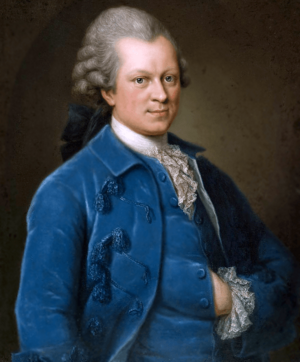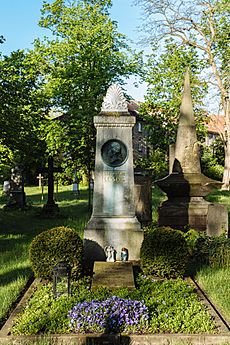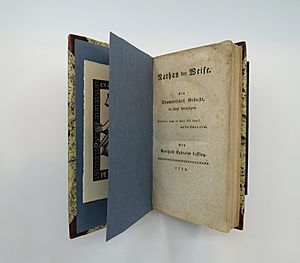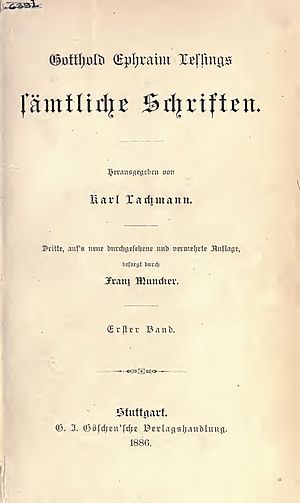Gotthold Ephraim Lessing facts for kids
Quick facts for kids
Gotthold Ephraim Lessing
|
|
|---|---|

Portrait of Lessing by Anna Rosina Lisiewska during his time as dramaturg of Abel Seyler's Hamburg National Theatre (1767/1768)
|
|
| Born | 22 January 1729 Kamenz, Upper Lusatia, Saxony |
| Died | 15 February 1781 (aged 52) Braunschweig, Brunswick-Lüneburg |
| Occupation | Writer, philosopher, dramatist, publicist, art critic, and dramaturg |
| Alma mater | Leipzig University University of Wittenberg |
| Notable works | Miss Sara Sampson, Emilia Galotti, Minna von Barnhelm, Nathan the Wise, Laocoön, Hamburgische Dramaturgie |
| Spouse | Eva König |
| Signature | |
 |
|
Gotthold Ephraim Lessing (born January 22, 1729 – died February 15, 1781) was an important German writer, thinker, and playwright. He was a key figure during the Enlightenment period. This was a time when people focused on reason and new ideas.
Lessing's plays and writings greatly shaped German literature. Many theatre experts consider him the first dramaturg. A dramaturg is someone who helps a theatre company choose plays and understand them deeply. He held this role at the Hamburg National Theatre.
Contents
Lessing's Early Life and Education
Gotthold Ephraim Lessing was born in Kamenz, a small town in Saxony. His father was a Lutheran minister. Lessing went to the Latin School in Kamenz from 1737 to 1741.
His father wanted him to become a minister too. So, Lessing attended the Fürstenschule St. Afra in Meissen. After that, he went to Leipzig University in 1746. There, he studied many subjects, including theology, medicine, and philosophy.
Growing Interest in Theatre
At Leipzig University, Lessing met Karoline Neuber. She was a famous German actress. Lessing started translating French plays for her. This made his interest in theatre grow even more.
He wrote his first play, The Young Scholar, which Neuber produced in 1748. From 1748 to 1760, Lessing lived in Leipzig and Berlin. He worked as a reviewer and editor for newspapers.
In 1750, Lessing and his cousin, Christlob Mylius, started a theatre magazine. It only had four issues, but it showed Lessing was a serious theatre critic. In 1752, he earned his master's degree from the University of Wittenberg.
Work as a Secretary and Dramaturg
From 1760 to 1765, Lessing worked as a secretary in Breslau. This was during the Seven Years' War. During this time, he wrote his famous book Laocoön, or the Limitations of Poetry.
In 1767, Lessing started working at the Hamburg National Theatre. This was Germany's first permanent national theatre. He was hired as the theatre's critic of plays and acting. This job is now called dramaturgy. This made Lessing the very first dramaturg.
His work in Hamburg led to his important book, Hamburgische Dramaturgie. Sadly, the Hamburg Theatre closed after only three years due to money problems.
Librarian and Later Life
In 1770, Lessing became a librarian at the Herzog August Library in Wolfenbüttel. This library was very famous. He traveled a lot during this time. In 1773, he found Archimedes' cattle problem in a Greek book there. This math problem was not solved until 1880.
In 1776, he married Eva König. She passed away in 1778 after giving birth to their son, who also died young. Lessing died on February 15, 1781, at the age of 52, in Brunswick.
Lessing was also good friends with Moses Mendelssohn, a Jewish-German philosopher. Their friendship showed the Enlightenment's call for religious tolerance. This friendship made Lessing interested in religious discussions. He wrote some articles about his beliefs, but they were banned. This ban inspired him to write his famous play, Nathan the Wise.
Lessing's Important Works and Ideas
Lessing was interested in theatre from a young age. He wanted to create a new kind of German theatre. He disagreed with the strict rules of French theatre at the time.
His book Hamburgische Dramaturgie started as reviews of plays. But it became an analysis of how drama should be used. Lessing believed in Shakespeare's plays. He also supported a movement called Sturm und Drang (Storm and Stress). This movement rejected old theatre rules.
Lessing's own plays became models for German drama.
- Miss Sara Sampson and Emilia Galotti are considered early examples of bourgeois tragedies. These plays showed the struggles of everyday people, not just kings or queens.
- Minna von Barnhelm is a classic German comedy.
- Nathan the Wise is seen as the first German "drama of ideas."
His theoretical writings, Laocoön and Hamburg Dramaturgy, set standards for discussing art and literature. Lessing believed that dramaturgs should work closely with theatre groups.
Freedom of Thought and Religion
In his writings about religion, Lessing defended the right to freedom of thought. He questioned strict religious beliefs. He talked about "Lessing's Ditch." This idea asks how miracles from the past can prove religious truths today. He meant that historical facts, which can be doubted, cannot prove spiritual truths like God's existence.
Later in his life, Lessing studied theology and religion deeply. He found an unpublished manuscript that questioned Christian beliefs. He started publishing parts of it, which caused a big debate. The government eventually stopped him from publishing these ideas.
In response, Lessing wrote Nathan the Wise. In this play, a character asks which religion is the "most genuine." Nathan tells a story about three rings, suggesting that no one religion is the "correct" one. This play showed Lessing's Enlightenment ideas about religious tolerance. He believed that human reason could develop even without divine revelation. His writing The Education of Humankind explains these ideas.
Freedom was a main theme in Lessing's life. He wanted freedom for theatre from French models. He also wanted freedom for religion from strict church rules. He supported the idea that people should think for themselves.
Lessing also tried to be an independent writer. But it was hard to make a living as a free author back then. His plan for authors to publish their own works did not succeed.
Lessing is also important for his book Laocoön: An Essay on the Limits of Painting and Poetry. In this work, he explained that painting and poetry are different art forms. Painting shows things in space, while poetry shows things over time. He argued that they should not try to be exactly alike.
Selected works

- Der junge Gelehrte (The Young Scholar) (1748)
- Der Freigeist (The Freethinker) (1749)
- Die Juden (The Jews) (1749)
- Miss Sara Sampson (1755)
- Philotas (1759)
- Fabeln (Fables) (1759)
- Laokoön oder Über die Grenzen der Malerei und Poesie (Laocoön) (1767)
- Minna von Barnhelm (Minna of Barnhelm) (1767)
- Hamburgische Dramaturgie (1767–69)
- Emilia Galotti (1772)
- Anti-Goeze (1778) (written against Johann Melchior Goeze, a pastor)
- Nathan der Weise (Nathan the Wise) (1779)
- Ernst und Falk – Gespräche für Freymäurer (1776–1778)
- Die Erziehung des Menschengeschlechts (The Education of the Human Race) (1780)
English translations
- Fables and epigrams. London, Printed for J.& H.L. Hunt, 1825.
- Laocoon: or, The limits of Poetry and Painting, translated by William Ross. London, Ridgeway, 1836.
- Nathan the Wise: a dramatic poem in five acts, translated by Adolph Reich. London, A. W. Bennett, 1860.
- Nathan, the Wise. A dramatic poem of five acts, translated by Dr. Isidor Kalisch. New York, Waldheimer & Zenn, 1869.
- The Education of the Human Race, translated by Fred W. Robertson, M.A.. London, C.K. Paul & Co., 1881.
- Plays of Lessing: Nathan the Wise and Minna von Barnhelm, translated by Ernest Bell. London, G. Bell, 1888.
- Selected prose works of G. E. Lessing, translated by E. C. Beasley, B. A., and Helen Zimmern. London, G. Bell and sons, 1890.
- Lessing’s Emilia Galotti, with footnotes and vocabulary; New York, Hinds & Noble, 1899.
- Lessing’s Nathan der Weise, with footnotes and vocabulary. New York, Hinds & Noble, 1899.
- Laocoon. An essay upon the limits of painting and poetry: With remarks illustrative of various points in the history of ancient art, translated by Ellen Frothingham. Boston, Little, Brown, 1904.
- Laocoon, translated by Sir Robert Phillimore, London, G. Routledge & sons, 1905.
- Minna von Barnhelm, edited with an introduction, German questions, notes and vocabulary, by Philip Schuyler Allen. New York, Charles E. Merrill Co., 1907.
- Minna von Barnhelm; or, Soldier’s fortune translated by Otto Heller. New York, H. Holt and company, 1917.
- Nathan the Wise; a dramatic poem in five acts, translated and edited by Leo Markun. Girard, Kan., Haldeman-Julius Co., 1926.
- Laocoon, Nathan the Wise, Minna von Barnhelm, translated by William A. Steel. London, J. M. Dent & sons, ltd.; New York, E. P. Dutton & co., inc., 1930.
- Nathan the Wise, translated by Berthold August Eisenlohr. Ann Arbor, Mich., Lithoprinted by Edwards Brothers, inc., 1942.
- Nathan the Wise, translated by Guenther Reinhardt. Brooklyn, Barron's Educational Series, inc., 1950.
- Nathan the Wise; a dramatic poem in five acts, translated into English verse by Bayard Quincy Morgan. New York, Ungar, 1955.
- Theological Writings; Selections in Translation with an Introductory Essay, by Henry Chadwick. London, A. & C. Black, 1956.
- Lessing's Theological Writings. Selections in Translation, edited by Henry Chadwick. Stanford: Stanford University Press, 1957.
- Emilia Galotti: a tragedy in five acts, translated by Anna Johanna Gode von Aesch. Great Neck, N.Y., Barron's Educational Series, inc., 1959.
- Emilia Galotti, a tragedy in five acts, translated by Edward Dvoretzky. New York, Ungar, 1962, reprinted German Book Center, 2003.
- Hamburg dramaturgy, translated by Victor Lange. New York, Dover Publications, 1962. Reprint of Helen Zimmern's 1890 translation.
- Laocoon: an essay on the limits of painting and poetry, translated by Edward Allen McCormick. Indianapolis, Bobbs-Merrill, 1962.
- Minna von Barnhelm: a comedy in five acts, translated by Kenneth J. Northcott. Chicago, University of Chicago Press [1972]
- Nathan the Wise, Minna von Barnhelm, and Other Plays and Writings, edited by Peter Demetz with a foreword by Hannah Arendt. New York: Continuum, 1991.
- Nathan the Wise, with Related Documents, translated, edited, and with an introduction by Ronald Schechter. Boston/New York: Bedford/St. Martin's, 2004.
- Philosophical and Theological Writings, edited by H. B. Nisbet. Cambridge: Cambridge University Press, 2005.
Images for kids
See also
 In Spanish: Gotthold Ephraim Lessing para niños
In Spanish: Gotthold Ephraim Lessing para niños
- Fable
- Greek revival
- Lessing Monument, Tiergarten, Berlin
- Lessing Theater
- Pantheism controversy






